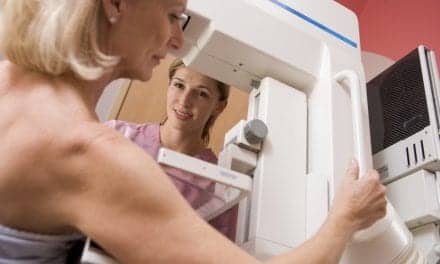By Aine Cryts
New patients registering at Little Rock, Ark.-based CARTI Cancer Center receive an iPad-based questionnaire that captures information to assess their risk of having breast cancer, Stacy Smith-Foley, MD, radiologist and medical director of the practice’s Breast Center, tells AXIS Imaging News. The practice captures demographics, family history, and lifetime estrogen exposure information that Smith-Foley’s care team needs to run a calculated risk model, which is a scientifically proven way to identify each woman’s personalized risk of having breast cancer, she says.
When a woman’s risk is elevated—namely, when it’s 20% or greater—that information is included in the mammogram report, says Smith-Foley, who adds that patients with a 20% or greater lifetime risk benefit from supplemental screening with breast MRI.
With these women, ideally, breast MRI is performed on an annual basis, and that should alternate with mammography at six-month intervals, she advises. “This helps get the patient set up in the National Comprehensive Cancer Network guidelines plan for high-risk surveillance. We’ll have the patient come in for a clinical breast exam every six months, which is facilitated by our practice’s cancer genetics risk management clinic.”
Smith-Foley presented a session called “Personalizing Mammography: Managing the High-Risk Patient to the Dense Breast Patient: Presented by Hologic, Inc.” at the Radiological Society of North America’s (RSNA’s) annual meeting, which took place in Chicago from December 1 to December 6. She was recently interviewed about breast cancer surveillance and risk assessment. As a follow-up to that conversation, AXIS Imaging News asked Smith-Foley about how risk management works at her practice. A lightly edited version of that conversation follows.
AXIS Imaging News: How does cancer genetics risk management work at your practice?
Stacy Smith-Foley: At the forefront are nurse practitioners, who are backed by medical oncologists and fellowship-trained breast surgeons. Patients receive a clinical breast exam every six months. We also look at the information we’ve collected in calculating the risk and help facilitate genetic testing.
We do genetic testing on screening and diagnostic patients through the Breast Center, where we identify patients with increased risk of genetic predisposition, not just to breast and ovarian cancers but to other cancers as well. We ask red-flag questions about their family history regarding different cancer types, such as male breast cancer, ovarian cancer, breast cancer in a woman younger than 50, pancreatic cancer, and metastatic prostate cancer.
In about nine questions, it’s pretty easy to flag a patient who would qualify for genetic testing, Smith-Foley tells AXIS. There are three different types of patients; they include:
- Patients who qualify for genetic testing. These patients get tested and they’re negative, and they don’t have an increased risk. That means they return for annual screenings.
- Patients who are negative but they’re at an increased risk. These patients are cared for by the practice’s high-risk patient clinic, where they’re followed by nurse practitioners on a long-term basis.
- Patients who test positive for one of the genetic mutations. Care team members need to have bigger conversations with these patients, who might consider more serious methods to reduce their risk, such as surgery, she says. For example, a woman might consider, if she’s completed child-rearing, having her ovaries removed to reduce estrogen exposure and reduce risk.
Having the backing of a risk-management clinic really helps, and our team communicates all of this information in our mammogram report. This helps facilitate communication among healthcare providers.
AXIS: Increasingly, patients are responsible for paying for more of the healthcare they receive. How does your practice help women navigate these financial responsibilities?
Smith-Foley: Cost can be an impediment. It helps when we document in a report the woman’s family history, particularly if she’s under the age of 40. For example, a woman’s health insurance plan may only pay for a yearly mammogram if she’s 40 years of age or older. Often, when we document a woman’s family history, her insurance will pay for her mammogram, even if she’s under the age of 40.
Still, we have to be honest with women. We often tell them that we don’t know if their insurance is going to cover this. At a bare minimum, women need to get a mammogram, but the data shows that high-risk women still need breast MRI; ultrasound doesn’t take the place of an MRI in a high-risk patient.
We do MRI on high-risk patients every day, and we’ve identified several mammographically occult breast cancers in these high-risk patients. Some of these patients have gene mutations, and some of them don’t. It’s different for the patient who’s at average risk, who has dense breast tissue. The average patient with dense breast tissue strongly benefits from supplemental screening with ultrasound. She doesn’t need an MRI. The benefits of an ultrasound are that it’s not tremendously expensive, it doesn’t expose her to any radiation, and it’s something that she can budget for.
In addition, women can plan ahead to pay for their breast cancer surveillance. For example, some women have access to a health-savings account or a flexible savings account through their employers.
Aine Cryts is a contributing writer for AXIS Imaging News.






